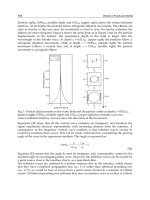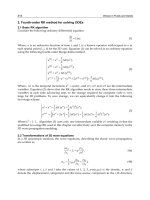Access: Acid-Base, Fluids, and Electrolytes - part 10 ppt
Bạn đang xem bản rút gọn của tài liệu. Xem và tải ngay bản đầy đủ của tài liệu tại đây (765.25 KB, 49 trang )
435
FIGURE 11–4: Approach to the Patient with Hypomagnesemia. If the diagnosis Is not readily apparent
from the history, either a 24-hour urine for Mg
2+
or spot urine for calculation of the fractional excretion
of Mg
2+
is obtained. The fractional excretion of Mg
2+
Is calculated from equation 11.1. Serum
Mg
2+
is multiplied by 0.7 since only 70% of Mg
2+
Is freely filtered across the glomerulus
436 DISORDERS OF SERUM MAGNESIUM
TABLE 11–14: Treatment
General principles
The route of Mg
2+
repletion varies depending on the severity
of associated symptoms
Since renal Mg
2+
excretion is regulated by the concentration
sensed at the basolateral surface of the TALH, an acute
infusion results in an abrupt increase in serum
concentration and often a dramatic increase in renal Mg
2+
excretion; for this reason much of intravenously
administered Mg
2+
is quickly excreted
Attempts are made to correct the underlying condition
Drugs that result in renal Mg
2+
wasting should be minimized
or discontinued
Life threatening symptoms—present
The acutely symptomatic patient with seizures, tetany, or
ventricular arrhythmias related to hypomagnesemia should
be administered Mg
2+
intravenously
In the life-threatening setting 4 mL (2 ampules) of a 50%
solution of magnesium sulfate diluted in 100 mL of normal
saline (16 mEq of Mg
2+
; 1 gm MgSO
4
=8 m Eq Mg
2+
) can
be administered over 10 min; this is followed by 50 mEq of
Mg
2+
given over the next 12–24 h
The goal is to increase serum Mg
2+
concentration above
1.0 mg/dL
Mg
2+
is administered cautiously in patients with impaired
renal function and serum concentration monitored
frequently
DISORDERS OF SERUM MAGNESIUM 437
TABLE 11–14 (Continued)
In the setting of chronic kidney disease the dose is reduced
by 50–75%
Life threatening symptoms—absent
In the absence of a life-threatening condition Mg
2+
is
administered orally
Oral administration is more efficient because it results in less
of an acute rise in serum Mg
2+
concentration
Amiloride increases Mg
2+
reabsorption in connecting tubule
and collecting duct and may reduce renal Mg
2+
wasting or
decrease the dose of Mg
2+
replacement if diarrhea becomes
problematic
Amiloride is not used in patients with impaired renal
function because of the risk of hyperkalemia
Abbreviations: TALH, thick ascending limb of Henle
438 DISORDERS OF SERUM MAGNESIUM
TABLE 11–15: Treatment—Specific Cardiovascular Settings
Ventricular and atrial arrhythmias in the setting of an
acute MI
Patients with mild hypomagnesemia in the setting of an
acute MI have a two- to threefold increased incidence of
ventricular arrhythmias in the first 24 h
This relationship persists for as long as 2–3 weeks after an
MI
Mg
2+
should be maintained in the normal range in this
setting
Torsades de pointes and refractory ventricular
fibrillation
The American Heart Association Guidelines for
Cardiopulmonary Resuscitation recommend the use
of IV Mg
2+
for the treatment of torsades de pointes
Torsades de pointes (1–2 grams magnesium sulfate in 10 ml
DSW over 5–20 min.) is a ventricular arrhythmia often
precipitated by drugs that prolong the QT interval; Mg
2+
does not shorten the QT interval and its effect may be
mediated via Na
+
channel inhibition
After cardiopulmonary bypass
Hypomagnesemia is common after cardiopulmonary bypass
and may result in an increased incidence of atrial and
ventricular arrhythmias
Studies on prophylactic Mg
2+
repletion in this setting are
conflicting
Abbreviations: MI, myocardial infarction; IV, intravenous
439
TABLE 11–16: Oral Mg
2+
Preparations
General principles
Slow release preparations of MgCl and Mg lactate are preferable since they cause less diarrhea
Diarrhea is the major side effect of Mg
2+
repletion
25–100 mEq/day in divided doses is generally required
Preparation MW Formula mg Mg
2+
/gm mEq Mg
2+
/gm
Mg carbonate 84 MgCO
3
289 24
MgCl 203 MgCl
2
• 6H
2
O 119 10
Mg gluconate 415 (CH
2
OH(CHOH)
4
COO)
2
Mg 58 5
Mg lactate 202 Mg(C
3
H
5
O
3
)
2
120 10
Mg oxide 40 MgO 602 50
Mg sulfate 246 MgSO
4
• 7H
2
O988
Abbreviation: MW, molecular weight
440 DISORDERS OF SERUM MAGNESIUM
HYPERMAGNESEMIA
TABLE 11–17: Etiologies of Hypermagnesemia
The kidney can excrete virtually the entire filtered Mg
2+
load
in the presence of hypermagnesemia; for this reason
hypermagnesemia is relatively uncommon unless high
doses are administered intravenously or there is a decrease
in glomerular filtration rate
IV Mg
2+
load in the absence of CKD
Treatment of preterm labor
Treatment of eclampsia
Oral Mg
2+
load in the presence of CKD
Laxatives
Antacids
Epsom salts
Miscellaneous
Salt water drowning
Abbreviations: IV, intravenous ; CKD, chronic kidney disease
DISORDERS OF SERUM MAGNESIUM 441
TABLE 11–18: Hypermagnesemia—Pathophysiology and
Presentation
It most often occurs with Mg
2+
administration in the setting
of a severe decrease in glomerular filtration rate
IV Mg
2+
Load in the Absence of CKD
Pathophysiology
High doses of Mg
2+
given intravenously can result in
hypermagnesemia even in the absence of CKD
Presentation
The typical setting is obstetrical with Mg
2+
infused for the
management of preterm labor or eclampsia
Typical protocols often result in serum Mg
2+
concentrations
of 4–8 mg/dL
Oral Mg
2+
Load in the Presence of CKD
The most common cause of hypermagnesemia is CKD
Pathophysiology
As glomerular filtration rate falls the fractional excretion of
Mg
2+
increases; this allows Mg
2+
balance to be maintained
until the glomerular filtration rate falls below 30 mL/min
Hypermagnesemia due to oral Mg
2+
ingestion occurs most
commonly in the setting of CKD
Presentation
Advanced age, CKD, and GI disturbances that enhance
Mg
2+
absorption such as decreased motility, gastritis, and
colitis are contributing factors
• Cathartics, antacids, and Epsom salts are frequently the
source of Mg
2+
(continued)
442 DISORDERS OF SERUM MAGNESIUM
TABLE 11–18 (Continued)
Lithium intoxication and familial hypocalciuric
hypercalcemia
• Presents with mild hypermagnesemia from decreased
renal excretion
• This is due to the interaction of lithium with the basolateral
Ca
2+
-Mg
2+
-sensing receptor in the TALH
• Antagonism of this receptor causes enhanced Mg
2+
reabsorption
Miscellaneous
Salt water drowning
• Seawater is high in Mg
2+
(14 mg/dL)
Abbreviations: IV, intravenous; CKD, chronic kidney disease; GI,
gastrointestinal; TALH, thick ascending limb of Henle
DISORDERS OF SERUM MAGNESIUM 443
TABLE 11–19: Signs and Symptoms
Signs and symptoms are primarily either neuromuscular
or cardiac
Neuromuscular
Mg
2+
blocks the synaptic transmission of nerve impulses;
initially this results in lethargy and drowsiness
As Mg
2+
concentration increases deep tendon reflexes are
diminished (4–8 mg/dL)
Deep tendon reflexes are lost and mental status decreases at
serum Mg
2+
concentrations of 8–12 mg/dL
At Mg
2+
concentrations >12 mg/dL flaccid paralysis and
apnea occur
Parasympathetic blockage resulting in fixed and dilated
pupils that mimics brainstem herniation was reported
Smooth muscle function can be affected resulting in ileus
and urinary retention
Cardiac
Mg
2+
blocks Ca
2+
and K
+
channels required for action
potential repolarization
At serum Mg
2+
concentrations above 7 mg/dL hypotension
and ECG changes such as PR prolongation, QRS widening,
and QT prolongation are noted
At Mg
2+
concentrations greater than 10 mg/dL ventricular
fibrillation, complete heart block, and cardiac arrest occur
Abbreviation: ECG, electrocardiogram
444 DISORDERS OF SERUM MAGNESIUM
TABLE 11–20: Diagnosis—Principles
Hypermagnesemia is often iatrogenic
A careful medication history is essential to determine the
Mg
2+
source, whether IV, as in the treatment of obstetrical
disorders or oral
Laxatives, antacids, and Epsom salts are the most common
oral Mg
2+
sources; high doses of IV Mg
2+
may result in
hypermagnesemia in the absence of CKD
Hypermagnesemia from increased gastrointestinal Mg
2+
absorption often requires some degree of renal impairment
The elderly are at increased risk, often because the degree of
decrease in glomerular filtration rate is not adequately
appreciated based on the serum creatinine concentration
The elderly often have decreased intestinal motility that
further increases intestinal Mg
2+
absorption
Abbreviations: IV, intravenous; CKD, chronic kidney disease; GI,
gastrointestinal
DISORDERS OF SERUM MAGNESIUM 445
TABLE 11–21: Treatment
Since the majority of cases of hypermagnesemia are
iatrogenic, caution should be exercised in the use of Mg
2+
salts especially in patients with CKD, those with GI
disorders that may increase Mg
2+
absorption, and the
elderly
Excessive Mg
2+
administration
The Mg
2+
source should be identified and discontinued
Patients with CKD should be cautioned to avoid Mg
2+
-
containing antacids and laxatives
If the patient has hypotension or respiratory depression, Ca
2+
(100–200 mg of elemental Ca
2+
over 5–10 min) is
administered intravenously
Increased renal Mg
2+
excretion
Renal Mg
2+
excretion is increased with a normal saline
infusion and/or furosemide administration
In the patient with severe CKD or end-stage renal disease
dialysis is often required
Hemodialysis is the modality of choice if the patient’s
hemodynamics can tolerate it, since it removes more Mg
2+
than continuous venovenous hemofiltration or peritoneal
dialysis
Abbreviations: CKD, chronic kidney disease; gastrointestinal;
IV, intravenous
This page intentionally left blank
447
12
Appendix
OUTLINE
Introduction 448
12–1. Regulation of RPF and GFR 448
12–2. Autoregulation of Renal Blood Flow 448
12–3. Tubuloglomerular Feedback Mediates 449
GFR Changes
12–4. Effect of Neurohormones on 450
Autoregulation and TGF
Clinical Assessment of GFR 451
12–5. Normal GFR with Age 451
12–6. Measures Available to Estimate 451
Kidney Function
12–7. Serum Creatinine Concentration as 452
a Measure of Kidney Function
12–8. Creatinine Clearance Measurement 453
12–9. Formulas to Estimate Creatinine 454
Clearance or GFR from Serum
Creatinine Concentration
12–10. Ion Conversions 455
Copyright © 2007 by The McGraw-Hill Companies, Inc.
Click here for terms of use.
448 APPENDIX
INTRODUCTION
TABLE 12–1: Regulation of RPF and GFR
RPF and GFR are critical to a number of the kidney’s
homeostatic functions
Regulation of RPF and GFR occurs through changes in
afferent and efferent arteriolar resistance
Autoregulation and TGF interact to maintain RPF and GFR
constant
Abbreviations: RPF, renal plasma flow; GFR, glomerular filtration
rate; TGF, tubuloglomerular feedback
TABLE 12–2: Autoregulation of Renal Blood Flow
Prevents large swings in RPF and GFR expected from
changes in arterial perfusion pressure
Effects are mediated through changes in afferent arteriolar
tone
• This maintains GFR constant until MAP < 70 mmHg or
> 160 mmHg
• GFR ceases at a MAP < 40–50 mmHg
Myogenic stretch receptors in the afferent arteriolar wall
play an important role in autoregulation
Autoregulation of the renal circulation maintains a relatively
constant RPF and GFR
TGF mediates changes in GFR through alterations in solute
delivery sensed by the macula densa
Abbreviations: RPF, renal plasma flow; GFR, glomerular filtration
rate; MAP, mean arterial pressure; TGF, tubuloglomerular feedback
APPENDIX 449
TABLE 12–3: TGF Mediates GFR Changes
Specialized macula densa cells, located at the end of the
TALH, sense changes in tubular fluid Cl
−
entry
Increases in renal perfusion increase GFR, which
enhances NaCl delivery to the macula densa
Signaling at the macula densa results in vasoconstriction of
the afferent arteriole and a reduction of GFR
This reduces glomerular capillary pressure (P
GC
) and returns
GFR toward normal and reduces NaCl delivery to the
macula densa
Reduced NaCl delivery, as occurs with prerenal
azotemia, has the opposite effect
Signaling at the macula densa results in vasodilation of the
afferent arteriole and an increase in GFR
The mediator(s) of TGF are not well understood
• Adenosine and thromboxane
■
Increased when excessive Cl
−
entry is sensed by macula
densa (constricting afferent arteriole)
■
Reduced when Cl
−
delivery is low, allowing afferent
arteriolar vasodilatation
• Nitric oxide modulates TGF response to NaCl delivery;
TGF is reset by variations in salt intake
■
Low NaCl delivery increases nitric oxide
■
Increased NaCl delivery reduces nitric oxide
Abbreviations: TGF, tubuloglomerular feedback; GFR, glomeru-
lar filtration rate; TALH, thick ascending limb of Henle
450 APPENDIX
TABLE 12–4: Effect of Neurohormones on Autoregulation
and TGF
Actions of systemic neurohormonal factors supersede
autoregulation and TGF in certain disease states such as
true or effective arterial blood volume depletion
Vasoconstrictor (SNS, RAAS, endothelin) and vasodilator
(prostaglandins, nitric oxide) substances are produced
Renal vasoconstriction is balanced by the production of
vasodilatory substances
• Prostaglandins (PGE
2
, PGI
2
) and nitric oxide
• NSAIDs tip balance in favor of vasoconstriction and
reduce GFR in states where the SNS or the RAAS are
activated
Abbreviations: TGF, tubuloglomerular feedback; SNS, sympa-
thetic nervous system; RAAS, renin-angiotensin-aldosterone
system; GFR, glomerular filtration rate; NSAIDs, nonsteroidal
anti-inflammatory agents
APPENDIX 451
CLINICAL ASSESSMENT OF GFR
TABLE 12–5: Normal GFR with Age
GFR measurement is essential in patients with kidney disease
Age adjusted normal GFR values are shown
Age GFR (mL/min/1.73 m
2
)
5–7 days 51 ± 6
1–2 months 65 ± 6
5–8 months 88 ± 12
9–12 months 87 ± 8
≥18 months 124 ± 26 male, 109 ± 13 female
Abbreviation: GFR, glomerular filtration rate
TABLE 12–6: Measures Available to Estimate
Kidney Function
Serum creatinine concentration
Age adjusted normal GFR values (Table 12–5)
Creatinine clearance measurement (24-h urine)
Radiolabeled iothalamate
Creatinine clearance estimation (Cockcroft-Gault equation)
GFR estimation (MDRD equations)
Abbreviations: GFR, glomerular filtration rate; MDRD,
Modification of diet in renal disease
452 APPENDIX
TABLE 12–7: Serum Creatinine Concentration as a Measure
of Kidney Function
Serum creatinine concentration is a common marker
employed to estimate kidney function
It is produced from metabolism of skeletal muscle creatine
Creatinine enters urine via filtration and tubular secretion
(organic cation transporter) in PCT
• Creatinine clearance overestimates GFR by 10–20%
• Creatinine secretion increases with declining GFR
Serum creatinine concentration alone is inaccurate and
suboptimal to estimate GFR
In men and women, serum creatinine concentration rises
little as GFR falls from 120 mL/min to 60 mL/min
Large changes in GFR result in minimal changes in serum
creatinine concentration (increased tubular creatinine
secretion)
Once GFR declines to 40–60 mL/min, tubular creatinine
secretion is maximized
• Small changes in GFR result in large changes in serum
creatinine concentration below this level
Abbreviations: PCT, proximal convoluted tubule; GFR, glomerular
filtration rate
APPENDIX 453
TABLE 12–8: Creatinine Clearance Measurement
Creatinine clearance is calculated by the formula shown
below:
CrCl (mL/min) = [UCr (mg/dL) × Volume (mL/min)]
÷ PCr (mg/dL) (12-1)
PCr is plasma creatinine concentration; UCr is 24-h urine
creatinine concentration and volume is the total urine
volume
Problems with 24-h urine include
• Creatinine clearance is an inaccurate measure of GFR
(overestimates GFR)
• Cimetidine administration competitively blocks tubular
cell creatinine secretion and enhances test accuracy
• Combining creatinine and urea clearance gives a close
estimate at lower GFR levels
• Problems with patient collection of urine sample
(under/overcollection)
Examining the ratio of creatinine to body weight in
kilograms assesses the completeness of the collection
• Women should excrete 15–20 mg/kg of creatinine/day
• Men should excrete 20–25 mg/kg of creatinine/day
Abbreviation: GFR, glomerular filtration rate
454 APPENDIX
TABLE 12–9: Formulas to Estimate Creatinine Clearance
or GFR from Serum Creatinine Concentration
Radiolabeled iothalamate provides an accurate estimate of
GFR; it is not widely available, and is expensive and
cumbersome
Equations were created using serum creatinine concentration
(and other data) to more accurately estimate creatinine
clearance or GFR
• Cockcroft-Gault equation (estimates creatinine clearance)
([140Ϫage (years)] × weight in kg
Ϭ [72 × serum creatinine (mg/dL)]
× 0.85 for females) (12-2)
• MDRD equations (accurately estimate GFR when
< 60 mL/min)
■
MDRD equation 7 requires BUN and serum albumin
concentrations
(170 × [serum creatinine (mg/dL)]
Ϫ0.999
× [age (years)]
Ϫ0.176
× [0.762 if female]
× [1.18 if African-American]
× [BUN (mg/dL)]
Ϫ0.170
× [albumin (g/dL)]
ϩ0.318
) (12-3)
■
Abbreviated form of the MDRD equation also
accurately estimates GFR
(186 × [serum creatinine (mg/dL)]
Ϫ1.154
× [age (years)]
Ϫ0.203
× [0.742 if female]
× [1.21 if African-American]) (12-4)
Abbreviations: GFR, glomerular filtration rate; BUN, blood urea
nitrogen; MDRD, modification of diet in renal disease
APPENDIX 455
TABLE 12–10: Ion Conversions
Sodium
1 gm = 43 mEq, 1 mEq = 23.25 mg, 1gm NaCl = 17 mEq Na
+
Potassium
1 mEq = 40.9 mg
Phosphorus
1 mmol/L = 3.12 mg/dL, 1 mmol = 31.25 mg
Calcium
Atomic weight—40.08, 1 mmol/L = 4 mg/dL, 1 mg/dL = 0.25
mmol/L
Magnesium
Atomic weight—24.3, 1 mmol = 24.3 mg, 1 mEq = 12 mg
This page intentionally left blank
457
Index
Copyright © 2007 by The McGraw-Hill Companies, Inc.
Click here for terms of use.
This page intentionally left blank
INDEX 459
Note: Figures are indicated by f following the page reference
acetazolamide, 109–110, 125,
152, 222, 243, 286
acid-base balance assessment
approach of patients,
189–192
bicarbonate reclamation,
182–183
new bicarbonate production,
distal nephron, 184
acid-base biology/chemistry
acid-base balance
assessment, 180
acid-base homeostasis, 175
buffering
bicarbonate system, 179,
180
Brønsted-Lowry defini-
tion, 176
in intracellular/extra-
cellular spaces, 178
f
Lewis definition,
176–177
protons, loss/gain, 181
f
acid-base homeostasis
general principles, 175
role of kidney, 180
acid-base nomogram, 304
f
acidemia, 141–142, 189, 193,
219
Addison’s disease (hypo-
adrenalism), 160,
241, 320, 331
adipsia, 94
adrenal gland hemorrhage, 241
adrenal hyperplasia, congenital,
265, 279
AE1 (SLC4A1) mutations, 238
albumin.
See also
hypoalbuminemia
buffering capacity, 176
characteristics, 11
and ECF ionized calcium
regulation, 310
extracorporeal surface
coating, 19
and hypervolemic
hyponatremia, 86
as plasma volume
expander, 12
receptor function/von
Willebrand factor
reduction, 19
vs. hetastarch in CPB, 19
alcoholic ketoacidosis, 172,
208, 211
aldosterone action mecha-
nisms, metabolic
alkalosis
cellular actions, 260
distal nephron H
+
secretion
effects, 260
distal nephron K
+
secretion
effects, 260
aldosterone deficiency, 226
etiologies, 241
medications, 241
alkalemia, 141–142, 189,
251
amiloride, 101, 116, 126, 163,
243, 272, 418
ammoniagenesis, 187–188,
295









